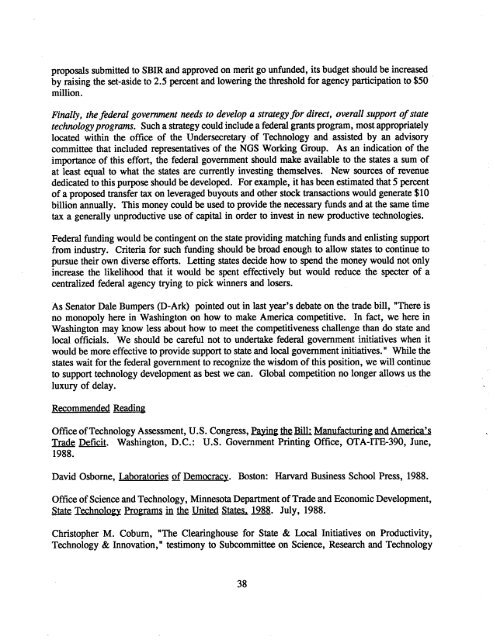WHOI-90-52
WHOI-90-52
WHOI-90-52
Create successful ePaper yourself
Turn your PDF publications into a flip-book with our unique Google optimized e-Paper software.
proposas submitted to SBIR and approved on merit go unfunded, its budget should be increase<br />
by rasing the set-aside to 2.5 percent and lowering the threshold for agency paricipation to $50 .<br />
milion.<br />
Finally, the federal governnt needs to develop a strategy for direct, overall support of state<br />
technology program. Such a strategy could include a federa grats program, most appropriately<br />
locted within the offce of the Undersereta of Technology and assisted by an advisory<br />
committee that included representatives of the NGS Working Group. As an indication of the<br />
importce of this effort, the federal government should make available to the states a sum of<br />
at least equa to what the states are currently investing themselves. New sources of revenue<br />
dedicate to this purpse should be develope. For example, it has been estimated that 5 percent<br />
of a propose trsfer ta on leveraged buyouts and other stock trsactions would generate $10<br />
billon annualy. This money could be use to provide the necssa funds and at the same time<br />
ta a generally unproductive use of capita in order to invest in new productive tehnologies.<br />
Federal funding would be contingent on the state providing matching funds and enlisting support<br />
from industr. Criteria. for such funding should be broad enough to allow states to continue to<br />
pursue their own diverse efforts. Letting states decide how to spend the money would not only<br />
increase the likelihoo that it would be spent effectively but would reduce the speter of a<br />
centralized federal agency tring to pick winners and losers.<br />
As Senator Dale Bumpers (D-Ark) pointed out in last yea's debate on the trade bil, "There is<br />
no monopoly here in Washington on how to make America competitive. In fact, we here in<br />
Washington may know less about how to meet the competitiveness challenge than do state and<br />
loc officials. We should be careful not to underte federa government initiatives when it<br />
would be more effective to provide support to state and loc government initiatives. II While the<br />
states wait for the federal government to recognize the wisdom of this position, we wil continue<br />
to support technology development as best we ca. Global competition. no longer allows us the<br />
luxury of delay.<br />
Recommended Reading<br />
Office of Technology Assessment, U.S. Congress, Paying ~ Bil: Manufacturing and America's<br />
Trade Deficit. Washington, D.C.: U.S. Government Printing Office, OTA-ITE-3<strong>90</strong>, June,<br />
1988.<br />
David Osborne, Laboratories of Democracy. Boston: Harard Business School Press, 1988.<br />
Office of Science and Technology, Minnesota Deparment of Trade and Economic Development,<br />
State Technology Programs in the United States. 1988. July, 1988.<br />
Christopher M. Coburn, "The Cleanghouse for State & Lo Initiatives on Productivity,<br />
Technology & Innovation," testimony to Subcommittee on Science, Resech and Technology<br />
38
















